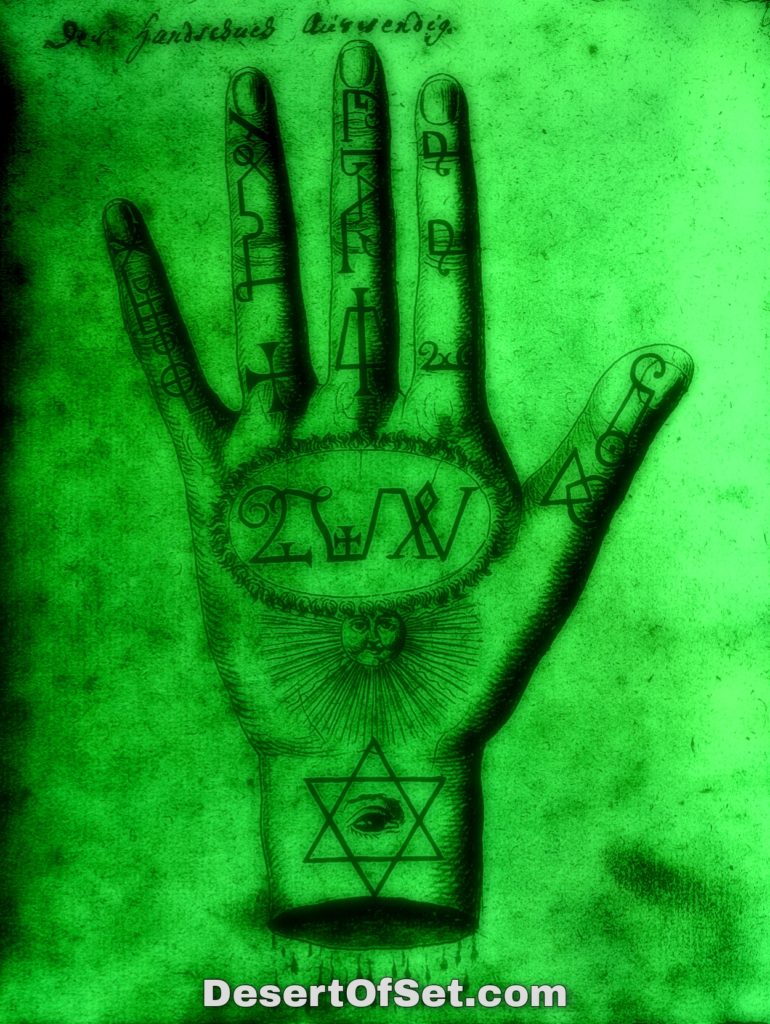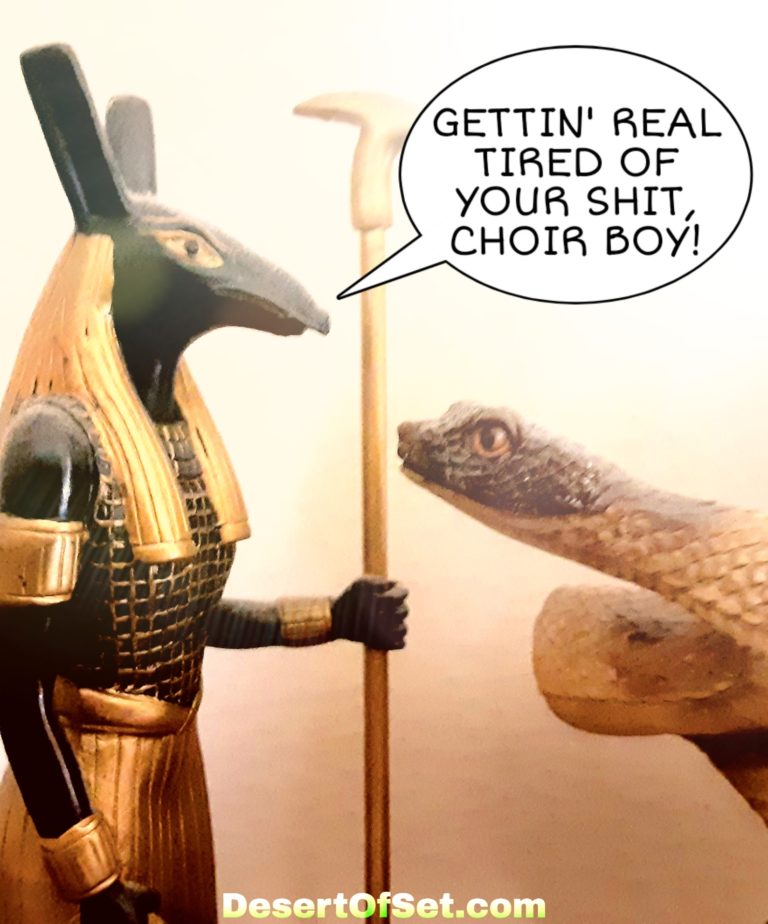On the conflation of all Setian spirituality with what Western occultists call “the left-hand path,” and why this is problematic.

Setianism is often linked with something Western occultists call “the left-hand path,” and this is thanks largely to the Temple of Set. The term originates from Hindu and Buddhist Tantra, in which the Vama Marga or “left-handed way” to enlightenment involves practices that most orthodox believers find “repugnant” (e.g., erotic mysticism). Helena Blavatsky, the founder of Theosophy, appropriated the name for virtually any kind of Western occultism she didn’t like. Ever since then, it has been evocative of “black magic” and “devil worship.”
Most other occult writers followed Blavatsky’s example in this respect, including Aleister Crowley, the founder of Thelema (who was himself regarded as a “brother of the left-hand path” by many of his contemporaries due to his controversial views and practices). The first Western writer to actually adopt the left-hand path (or “LHP” for short) as a positive self-label was Kenneth Grant, a protege of Crowley’s who developed his own “Typhonian” school of Thelema. Grant’s philosophy hinges on Set rather than Horus, and it has much to do with contacting qliphothic forces from alternate universes via the use of sexual magic. Grant was also a UFOlogist and a pioneer in Lovecraftian occultism, or the use of H.P. Lovecraft’s “Cthulhu Mythos” in actual esoteric practice. His use of the term “left-hand path” is probably the closest I have seen among Western sources to the original Tantric idea of the Vama Marga (perhaps because Grant studied under an actual Indian guru, Ramana Maharshi).
The next Western writer to adopt the left-hand path was Anton LaVey, founder of the Church of Satan. LaVey conceptualized the LHP as being like a carnival huckster’s take on spirituality: it’s all “make-believe,” we are just meat machines that cease to exist upon death, and there are no actual Gods or spirits to hear any of our prayers. But at the same time, there is nothing wrong with all of this “make-believe” so long as it enriches and empowers the “believer.” In LaVey’s worldview, conventional religions (“the right-hand path”) use made-up dogmas to control the masses, while the left-hand path uses such fantasy to liberate the individual instead. Success is measured not by any spiritual advancement, but by purely material milestones. For example, a successful actor or musician would be considered far more adept at “the black arts” than someone who can recite each of the Enochian Keys by heart, but who flips burgers at McDonald’s for a living.
Michael Aquino, the founder of the Temple of Set, developed a radically different construct from that of LaVey. His LHP is a more metaphysical process of “immortalizing the psyche,” with the potential achievement of a sentient afterlife being the ultimate goal. For Aquino and his followers, the problem with conventional religion is that it stifles the powers of the mind, leading to a total dissolution of consciousness after death. If people just ditched such creeds and started exercising their minds intellectually and metaphysically, they’d have a much better chance of becoming discarnate alien intelligences when they die—or so the theory goes. If there is one element of LaVeyan belief that Aquino maintained, it is the claim that authentic LHPers do not actually “worship” any of the forces they evoke in their magic (including Set Himself). Aquino’s take centers on worshiping one’s own highest potential to the exclusion of anyone or anything else that might (or might not) exist.
Many additional Western LHP perspectives would bloom over the following decades, including those of Zeena and Nikolas Schreck, Michael W. Ford, and Thomas Karlsson. Notable themes that many sects seem to share include autotheism (the worship of oneself); an indiscriminate affinity for so-called “dark” forces (like conflating Set with Apep); an intersection of Gnosticism, hedonism, nihilism, and/or anti-cosmicism; and a rather unfortunate disposition toward right-wing sociopolitical ideologies (from American Libertarianism to outright National Socialism). The very worst example of this would be the Order of the Nine Angles, whose supporters are known to be terrorists and white supremacists. Even among LHPers who do not entertain such views seriously, there is an ugly tendency to glorify fascist imagery (often because it is “shocking” or “cool”), going all the way back to Anton LaVey’s inclusion of “Might is Right” (a racist diatribe by Ragnar Redbeard) in 1969’s The Satanic Bible.
Though many Setians identify as “left-hand path,” not all of us do. Part of the confusion on this stems from the fact that many Setian writers are either Temple of Set members or adherents to some variation of its philosophy. This has always been something of a “pet peeve” for me personally, because I think the word Setian really belongs to Set. It is understood that not all Setians will believe or practice the same way, as Set loves variety and freedom. But if any particular theme should be the one common element that we all share, that theme is and must be SET HIMSELF—not the Book of the Law, The Nightside of Eden, the Satanic Bible, or the Book of Coming Forth By Night. This does not preclude Setians from sharing additional interests; but Set was there long before Vama Marga, Typhonian Thelema, LaVeyan Satanism, the Temple of Set, or any other LHP variant, and a person doesn’t need EITHER of those things to know Set and walk with Him. To claim otherwise is to ignore the fact that Setianism began over five millennia ago as a North African animist and polytheist tradition in which our Namesake was clearly revered and venerated (as He deserves to be).
Which returns us to the matter of right-wing ideological influences in Western LHP circles. This rather disgusting tendency is made all the more revolting whenever it happens to manifest among so-called “Setians.” For one thing, Set is an Egyptian God, and the Egyptians were a North African people. They were PEOPLE OF COLOR, you idiots. We owe everything to them, too; there is not a single white person who would be walking with any of the Netjeru today if it hadn’t been for these blessed ancestors. So if you pay lip service to an Egyptian God while supporting white supremacy, you are a fucking idiot and you deserve to have your ass handed to you. Furthermore, Set is the absolute WORST mascot for any kind of fascist cause, given that His hatred for authoritarianism is purer than venom. We call Him “He Who Commands the Riot” for a reason, you know. Set is a God who smites other Gods whenever they need smiting, and He has even less patience with human megalomaniacs. If you take His name but support tyranny, you are no Setian; you are just a servant of Apep in disguise—and we Setians know just how to deal with Apep!

I’m willing to bet that most of Set’s people today are probably Kemetics or some other flavor of devotional polytheist—or at least, that is how it looks across the internet (which is probably a better reflection of things today than it was in the 1990s). We devotionalists have just as much right to Set’s name as any Thelemite, Satanist, or Chaos Magician (if not more), and I for one insist on taking ownership of the term Setian for this reason. LHPers are welcome to walk with Set too in my book, but they are NOT welcome to look down their noses at those of us who actually revere and venerate Him as the ancients did. And those who favor any of that “might is right” fuckery should just pack their shit and leave. It seems egregiously stupid that I should even have to say this to anyone, but y’all are just gonna have to live with the fact that there are Setians who worship and pray to Set, who are animists and polytheists, and who believe in trying to make things better for everyone, not just ourselves.
